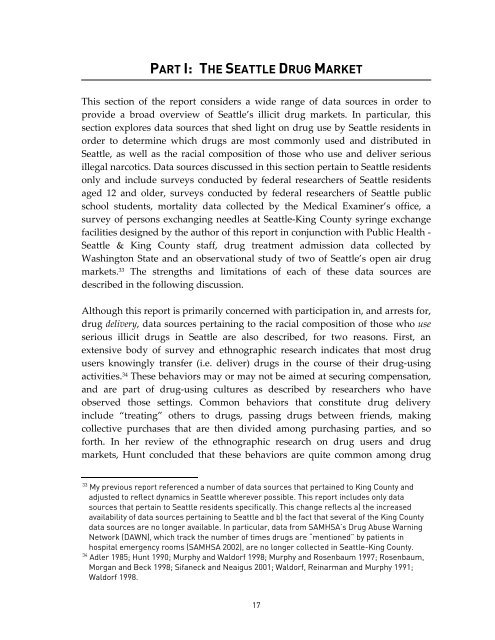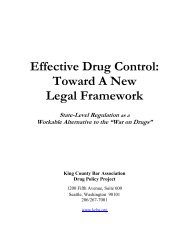RACE AND THE ENFORCEMENT OF DRUG DELIVERY LAWS IN ...
RACE AND THE ENFORCEMENT OF DRUG DELIVERY LAWS IN ...
RACE AND THE ENFORCEMENT OF DRUG DELIVERY LAWS IN ...
You also want an ePaper? Increase the reach of your titles
YUMPU automatically turns print PDFs into web optimized ePapers that Google loves.
PART I: <strong>THE</strong> SEATTLE <strong>DRUG</strong> MARKET<br />
This section of the report considers a wide range of data sources in order to<br />
provide a broad overview of Seattle’s illicit drug markets. In particular, this<br />
section explores data sources that shed light on drug use by Seattle residents in<br />
order to determine which drugs are most commonly used and distributed in<br />
Seattle, as well as the racial composition of those who use and deliver serious<br />
illegal narcotics. Data sources discussed in this section pertain to Seattle residents<br />
only and include surveys conducted by federal researchers of Seattle residents<br />
aged 12 and older, surveys conducted by federal researchers of Seattle public<br />
school students, mortality data collected by the Medical Examiner’s office, a<br />
survey of persons exchanging needles at Seattle-King County syringe exchange<br />
facilities designed by the author of this report in conjunction with Public Health -<br />
Seattle & King County staff, drug treatment admission data collected by<br />
Washington State and an observational study of two of Seattle’s open air drug<br />
markets. 33 The strengths and limitations of each of these data sources are<br />
described in the following discussion.<br />
Although this report is primarily concerned with participation in, and arrests for,<br />
drug delivery, data sources pertaining to the racial composition of those who use<br />
serious illicit drugs in Seattle are also described, for two reasons. First, an<br />
extensive body of survey and ethnographic research indicates that most drug<br />
users knowingly transfer (i.e. deliver) drugs in the course of their drug-using<br />
activities. 34 These behaviors may or may not be aimed at securing compensation,<br />
and are part of drug-using cultures as described by researchers who have<br />
observed those settings. Common behaviors that constitute drug delivery<br />
include “treating” others to drugs, passing drugs between friends, making<br />
collective purchases that are then divided among purchasing parties, and so<br />
forth. In her review of the ethnographic research on drug users and drug<br />
markets, Hunt concluded that these behaviors are quite common among drug<br />
33 My previous report referenced a number of data sources that pertained to King County and<br />
adjusted to reflect dynamics in Seattle wherever possible. This report includes only data<br />
sources that pertain to Seattle residents specifically. This change reflects a) the increased<br />
availability of data sources pertaining to Seattle and b) the fact that several of the King County<br />
data sources are no longer available. In particular, data from SAMHSA’s Drug Abuse Warning<br />
Network (DAWN), which track the number of times drugs are “mentioned” by patients in<br />
hospital emergency rooms (SAMHSA 2002), are no longer collected in Seattle-King County.<br />
34<br />
Adler 1985; Hunt 1990; Murphy and Waldorf 1998; Murphy and Rosenbaum 1997; Rosenbaum,<br />
Morgan and Beck 1998; Sifaneck and Neaigus 2001; Waldorf, Reinarman and Murphy 1991;<br />
Waldorf 1998.<br />
17

















